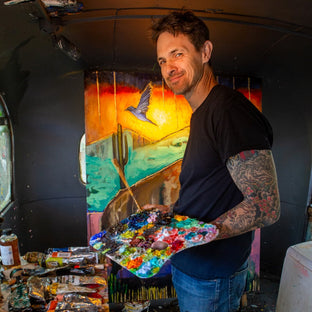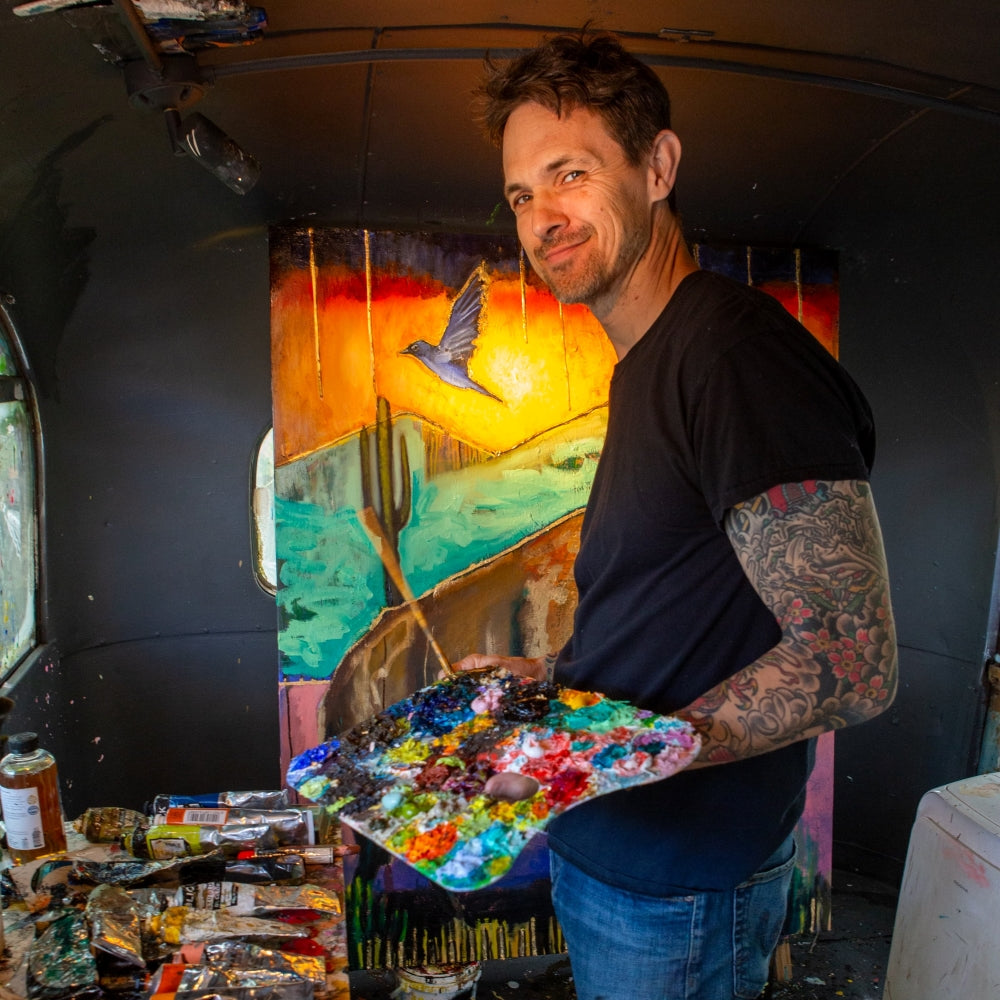A Creative Interview With Artist Scott Dykema



"My work is something of a constant evolution. It is something that feels impersonal yet is the most personal thing I know. It is created out of love and only out of love."
Artist Scott Dykema creates mixed-media figurative works reminiscent of contemporary street art. His compositions depict the interpretation of cultures through multiple layers and metallic elements. He studied nutrition and dietetics in college, but an art teacher inspired him to pursue a creative path, a passion he has had since childhood. Scott listens to music and comedy podcasts while he paints from a 1947 Chevy school bus parked in his Texas backyard. When not making art, Scott enjoys working out and spending time with his family.
In this interview, Scott shares his inspirations, dreams, and a memorable observation someone made about his work.
What’s your home life like?
My home life is what my life is all about. It is the place where I feel comfortable and at peace. It is comfortable enough to understand who I am. It is the place I want to be more than anywhere. I have love all around me, and I am around those who fully support me and who I am, even when I think I should be someone else. My family has taught me how to love and how to be a good person. They have taught me how to love myself. We all enjoy spending time together. I love to cook and make food for those I love. Cooking is something that I enjoy as much as I like art. It is so rewarding. I love my dog Milly, and I enjoy watching her be her. I love sitting, drinking coffee, and talking with my wife. I feel like I am in a better place than I could have ever dreamed of.
What are you most proud of—whether in art or another part of your life?
I am most proud of my family and relationships. I have good people in my life, I have good habits, and I find happiness in the simplest things. I am proud of my son, and I am proud of the life I live. I have managed to find work and a multitude of creative possibilities to keep myself and my family going so that I can make art pretty regularly. It has not been easy, but I am proud that I haven’t quit.
Do you have any studio rituals that help you get into a creative flow?
I wish I had one, but the thing that works for me and my creativity is simply starting to paint. I usually have no idea what I will do when I start working, and then once it gets going, I will have an idea. I respond to that, work from that, and keep moving. Sometimes it's hard. Actually, it's hard a lot of the time, but doing anything without a plan or a roadmap is always hard. Not knowing what's next is hard. But I think that just getting started is what works for me.
How do you structure your day?
I am pretty disciplined. I get up early, feed the pets, make coffee, and do some cleaning and picking up. After that, I sit down and read spiritually inspired books and write for 30 minutes to check in and see how things are going inside my head. Then, I take my dog for a walk and come back to exercise. After that, I get into the studio. I usually work from around 9 to 5. I make food, take care of whatever else I need to, and then relax with my family. I try to get to sleep early and aim for 8 hours of sleep. A disciplined routine is what works best for me. It feels like a must.
Where do you find inspiration for your art?
I get inspiration from everything and everyone, pretty much. I get a lot of inspiration from my wife, my pets, the tattoo shops I visit, art books, textures, colors, nature, wildlife, features or attitudes of various female archetypes, the plants and flowers around the house or out on my walks, and watching shapes come together when I make random marks with a pen on paper. I am inspired by various cultures and traditions, their flags, and their clothes. I am inspired by the weather and the fog, by the sea and the wind, and by the ways things change relative to their location and color.
Tell us about your evolution as an artist.
I started drawing when I was really young. When I got my first desk, it became my place to draw. It was a big desk, and I worked on big papers. I would draw for hours. I started taking portrait drawing lessons when I was in middle school. I went to college to get my degree in dietetics and nutrition, but my first painting class immediately threw me in another direction. I fell in love with painting right away.
During my last year of college, I met a woman who introduced me to the world of decorative painting and mural painting. I painted with her for a year, and after graduation, I started a business with my wife called Daydream Studios. We specialized in decorative painting and murals in homes all over Dallas and Fort Worth. We built the business by ourselves, and it grew pretty quickly once we started getting meetings with interior designers. While doing that by day, I was also painting in my studio at night. I started out working in a barn making art, and it was rough in the Texas summers and winters without any air conditioning or heat, but I made it through.
After years of making art, I started to get small opportunities to be in small shows. Now, after 20 years, I am represented by multiple galleries. My studio is now a 1947 school bus parked right behind our house. I am still getting work doing interior decorative painting, refinishing cabinets, painting murals, and doing custom plaster finishes. I just started another business called Beakon Studios. The new business will focus on one-of-a-kind apparel. That will start sometime this summer and will have an official event launch in mid-October. I am really excited about it all!

How do you decide when an artwork is finished?
This is so hard to answer. First, I focus on maximizing and then editing. Then, I check the color repeatedly and look at it compositionally. Next, I ask: has it been edited as much as it can be? After all of that, I usually know if it’s finished. However, I have made things in the past and, years later, pulled them out and added more details to make them even stronger. It’s hard to say.
What is the most interesting observation someone has made about your work?
I think I have had a few that blew my mind! I created a mural at a martial arts studio several years back. The mural was almost 50 feet long and about 15 feet tall. The work was something I had created after discussing a very loose idea of various subjects and color schemes with the client. After working on it for a week during the evenings, I finished the mural. The day after I finished, some of the high-ranking martial arts students came through to see the mural. One of them stopped me to explain how I had unknowingly painted the chronological history of martial arts. It was an amazing observation because I didn’t know anything about the history of martial arts, specifically Tae Kwon Do. I just started working, and I didn’t start at one side or the other. I just worked as I found images that appealed to me, and it just took shape over time.
The work that I make is not something that I really feel I create. I feel that it comes from somewhere else, and I just kind of put the work out into existence. I am just a tool. I love that. It takes the pressure off. I know that there will be meaning in what I make to the right person at the right time. It is magic. I have had other observations like this that have blown my mind, but this project was so enormous it kind of opened me up to the fact that through creating I get to connect with something omniscient.
Is there an artwork from another artist that has had a significant impact on you?
Probably the painting called The Icebergs by Frederic Edwin Church. I saw it at the Dallas Museum of Art on my first date with my wife. She wanted to show it to me. I had never had a person tell me they wanted to show me a piece of art. I saw it, and it blew my mind. It was so large, and the icy blues were so vibrant and felt cool. I was there with the girl who would later become my wife, and I just knew good things were happening. The painting is magnificent and impressive and representational, but it is packed with feeling, and the color work is breathtaking. A masterful piece of art, but the color is more impactful than the mastery of the ice’s accuracy.

What’s your favorite museum?
The Kimbell Art Museum in Fort Worth, TX. I know there are probably better museums. There are so many I have not been to, but this one is special to me for so many reasons. For one, they have an amazing permanent collection. You don't ever have to go to one of their traveling shows, ever. Their collection is always better than anything that makes a temporary visit there. The building is beautiful! Also, when I illustrated a children's book, they asked us to do an artist talk there. It was a huge honor. There was a woman who was kind of in charge of everything, and she brought me in to teach some classes and talk to people about the art. It is always a huge honor anytime I get a message from her. I love that place for too many reasons to name any other museum.

Is there anything else you’d like to share to help viewers better understand your work?
My work is something of a constant evolution. It is something that feels impersonal yet is the most personal thing I know. It is created out of love and only out of love. I do not make art to make a statement from my mind. If a statement is present, then it is made by the observer. I make art with any materials, and that is something that brings me a great amount of joy and intrigue. It feels like a limitless experience, and that is the way I like to play. Once I learned to accept that I do not make subject-based art and that my art is process-driven, I let myself go. I stopped trying to do what I thought I should, and it has only gotten better from there.
Discover more artist features on UGallery
If you enjoyed this article about Scott Dykema's life and artwork, we recommend reading about Mary Pratt's contemporary paintings of women and Alana Clumeck's animal art.







